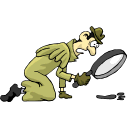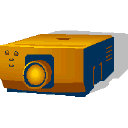 Up until this point, you have been
investigating
the processes of determining the age of the Earth, determining the
importance
of fossils to learning about prehistoric organisms and tracing the
change
of species over time. During previous assignments, you
examined
the process of natural selection first-hand. Remember that the
actual
processes of natural selection and evolution take place over long
periods
of time and we are rarely capable of observing these processes
directly.
As you have seen, the fossil record is a valuable tool scientists use
to
observe the process of evolution; however, the fossil record is not the
only
evidence scientists have discovered that makes it possible to determine
if
a process has taken place.
Up until this point, you have been
investigating
the processes of determining the age of the Earth, determining the
importance
of fossils to learning about prehistoric organisms and tracing the
change
of species over time. During previous assignments, you
examined
the process of natural selection first-hand. Remember that the
actual
processes of natural selection and evolution take place over long
periods
of time and we are rarely capable of observing these processes
directly.
As you have seen, the fossil record is a valuable tool scientists use
to
observe the process of evolution; however, the fossil record is not the
only
evidence scientists have discovered that makes it possible to determine
if
a process has taken place.
In this assignment, you will look for more evidence of change in living things over time. The class will be divided into six groups. Your Instructor will assist you in establishing your groups. Each group will be assigned a topic to investigate from the following list. Cytology - This group will search for cytological similarities and differences among living things. Members of this group may find the cell theory to be a good place to begin their investigation.  The groups will be given all of the remaining
portion of today's class and until next week's class to conduct
research
on their topic and to develop a presentation to deliver the information
they
uncover to the rest of the class. As you conduct your research, remember
that the theme of each group is "Evidence of Change in Living Organisms
Over
Time." Make sure that your presentation focuses on that theme
and
includes all information relevant to the topic. Presentations are
to
be delivered using a projector and Power Point slide show as the
medium.
Presentations should be between 8 and 10 minutes in length.
Because
there will be several presentations to deliver during our next meeting,
so
time limits will be enforced. You may choose to have more than
one
presenter, or delegate work so that some group members construct the
presentation while others deliver it. Every member of the group
is expected to contribute
equally to the success of the presentation. Be sure to rehearse
your
presentation in order to ensure you will be able to deliver your
presentation
effectively in the allowed time. The groups will be given all of the remaining
portion of today's class and until next week's class to conduct
research
on their topic and to develop a presentation to deliver the information
they
uncover to the rest of the class. As you conduct your research, remember
that the theme of each group is "Evidence of Change in Living Organisms
Over
Time." Make sure that your presentation focuses on that theme
and
includes all information relevant to the topic. Presentations are
to
be delivered using a projector and Power Point slide show as the
medium.
Presentations should be between 8 and 10 minutes in length.
Because
there will be several presentations to deliver during our next meeting,
so
time limits will be enforced. You may choose to have more than
one
presenter, or delegate work so that some group members construct the
presentation while others deliver it. Every member of the group
is expected to contribute
equally to the success of the presentation. Be sure to rehearse
your
presentation in order to ensure you will be able to deliver your
presentation
effectively in the allowed time. |